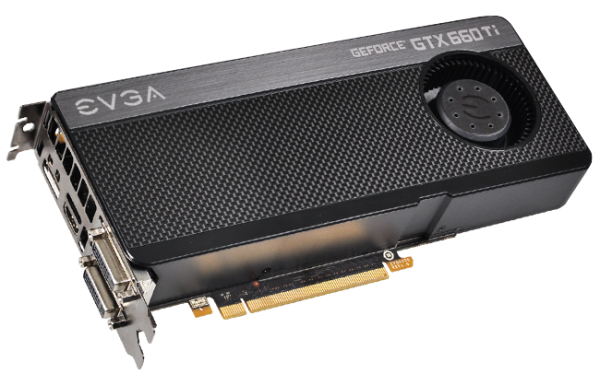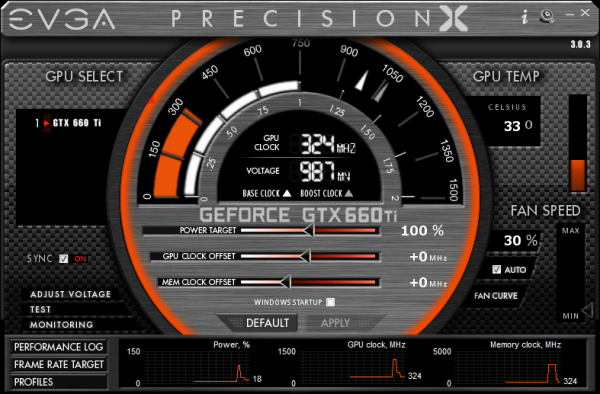The GeForce GTX 660 Ti Review, Feat. EVGA, Zotac, and Gigabyte
by Ryan Smith on August 16, 2012 9:00 AM ESTMeet The EVGA GeForce GTX 660 Ti Superclocked
Our first card of the day is EVGA’s entry, the EVGA GeForce GTX 660 Ti Superclocked. Among all of the GTX 670 cards we’ve looked at and all of the GTX 660 Ti cards we’re going to be looking at, this is the card that is the most like its older sibling. In fact with only a couple cosmetic differences it’s practically identical in construction.
| GeForce GTX 660 Ti Partner Card Specification Comparison | ||||||
| GeForce GTX 660 Ti(Ref) | EVGA GTX 660 Ti Superclocked | Zotac GTX 660 Ti AMP! | Gigabyte GTX 660 Ti OC | |||
| Base Clock | 915MHz | 980MHz | 1033MHz | 1033MHz | ||
| Boost Clock | 980MHz | 1059MHz | 1111MHz | 1111MHz | ||
| Memory Clock | 6008MHz | 6008MHz | 6608MHz | 6008MHz | ||
| Frame Buffer | 2GB | 2GB | 2GB | 2GB | ||
| TDP | 150W | 150W | 150W | ~170W | ||
| Width | Double Slot | Double Slot | Double Slot | Double Slot | ||
| Length | N/A | 9.5" | 7.5" | 10,5" | ||
| Warranty | N/A | 3 Year | 3 Year + Life | 3 Year | ||
| Price Point | $299 | $309 | $329 | $319 | ||
EVGA will be clocking the GTX 660 Ti SC at 980MHz for the base clock and 1059MHz for the boost clock, which represents a 65MHz (7%) and 79MHz (8%) overclock respectively. Meanwhile EVGA has left the memory clocked untouched at 6GHz, the reference memory clockspeed for all of NVIDIA’s GTX 600 parts thus far.
The GTX 660 Ti is otherwise identical to the GTX 670, for all of the benefits that entails. While NVIDIA isn’t shipping a proper reference card for the GTX 660 Ti, they did create a reference design, and this appears to be what it’s based on. Both the EVGA and Zotac cards are using identical PCBs derived from the GTX 670’s PCB, which is not unexpected given the power consumption of the GTX 660 Ti. The only difference we can find on this PCB is that instead of there being solder pads for 16 memory chips there are solder pads for 12, reflecting the fact that the GTX 660 Ti can have at most 12 memory chips attached.
With this PCB design the PCB measures only 6.75” long, with the bulk of the VRM components located at the front of the card rather than the rear. Hynix 2Gb 6GHz memory chips are placed both on the front of the PCB and the back, with 6 on the front and 2 on the rear. The rear chips are directly behind a pair of front chips, reflecting the fact that all 4 of these chips are connected to a single memory controller.
With the effective reuse of the GTX 670 PCB, EVGA is also reusing their GTX 670 cooler. This cooler is a blower, which due to the positioning of the GPU and various electronic components means that the blower fan is off of the PCB entirely by necessity. Instead the blower fan is located behind the card in a piece of enclosed housing. This housing pushes the total length of the card out to 9.5”. Housed inside of the enclosure is a block-style aluminum heatsink with a copper baseplate that is providing cooling for the GPU. Elsewhere, attached to the PCB we’ll see a moderately sized aluminum heatsink clamped down on top of the VRMs towards the front of the card. There is no cooling provided for the GDDR5 RAM.
Elsewhere, at the top of the card we’ll find the 2 PCIe power sockets and 2 SLI connectors. Meanwhile at the front of the card EVGA is using the same I/O port configuration and bracket that we saw with the GTX 670. This means they’re using the NVIDIA standard: 1 DL-DVI-D port, 1 DL-DVI-I port, 1 full size HDMI 1.4 port, and 1 full size DisplayPort 1.2. This also means that the card features EVGA’s high-flow bracket, a bracket with less shielding in order to maximize the amount of air that can be exhausted.
Rounding out the package is EVGA’s typical collection of accessories and knick-knacks. In the box you’ll find a pair of molex power adapters, a quick start guide, and some stickers. The real meat of EVGA’s offering is on their website, where EVGA card owners can download their wonderful video card overclocking utility (Precision X), and their stress test utility (OC Scanner X). The powered-by-RivaTuner Precision X and OC Scanner X still set the gold standard for video card utilities thanks to their functionality and ease of use. Though personally I’m not a fan of the new UI – circular UIs and sliders aren’t particularly easy to read – but it gets the job done.
Next, as with all EVGA cards, the EVGA GeForce GTX 660 Ti Superclocked comes with EVGA’s standard 3 year transferable warranty, with individual 2 or 7 year extensions available for purchase upon registration, which will also unlock access to EVGA’s step-up upgrade program. Finally, the EVGA GeForce GTX 660 Ti Superclocked will be hitting retail with an MSRP of $309, $10 over the MSRP for reference cards.






















313 Comments
View All Comments
RussianSensation - Thursday, August 16, 2012 - link
Oops forgot to link it:$317 HD7950 MSI TF3 -- perfect for skyrim with mods:
http://forums.anandtech.com/showthread.php?t=22616...
CeriseCogburn - Thursday, August 23, 2012 - link
BUT IT LOST to the 660Ti, and the 660Ti even beats the 7970 LOLhttp://www.bit-tech.net/hardware/2012/08/16/nvidia...
Oh well, time for a new game plan...
1300+ on 660Ti cores, exceeding 7950's and 7950's - R O F L goodbye amd
Ryan Smith - Saturday, August 18, 2012 - link
If you're going to be playing with memory-intensive mods then our Skyrim results at 2560 are going to be the most relevant. The 7870 would be appreciably faster here, but note that this is basically the only case in our entire benchmark suite where that happens (even Crysis has the two virtually tied). I suspect you'd be happy with either card, but if you intend to keep the card for a while and to play games other than Skyrim, I'd be hesitant to recommend the 7870.TheJian - Monday, August 20, 2012 - link
Not quite sure I understand...660TI is dominant in 1920x1200 in skyrim. I already showed from the hardware survey at steampowered.com <2% use your resolution of 2560x1600. I already pointed out 68 24in monitors at newegg (that's all of them by the way) don't recommend above 1920x1200/1080 for recommended res (native), 41 of the 27in monitors run the same, only 11 27in monitors on newegg recommend a resolution even near your 2560x1600 (it's 1440 on those 11), the rest of the other 41 27in models are also 1920x1080...Who do you think runs at this 2650x1600 res? It's a res used by a small % of the 2% I've just mentioned. You have to buy a 30in before this is useful info. Is this guy running a 30in? Crysis, tied? You talking warhead from an old engine from 2008 or what? See my other posts, you need to rewrite your conclusion and stop acting like there are more than 2% in the world using 2560x1600. I already proved this wrong many times in here in the comments on this article! Got any evidence skyrim is better for this guy? His link where nothing is explained? I believe he's testing at REF speeds for the 660TI since nothing is mentioned about what he runs the tests at (after translating the whole thing through google) . He has multiple cards but only 1 660TI in the test once he gets to the alan wake page and gaming tests. Again though, 1920x1080 the card is great. But still I have no idea of the clockspeed of the ONE card in the 3 card charts. Only ArmA2,Metro2033 seems to be a victory for 7950 (again at what speed?). I can't find evidence it's not all based on reference. But if you go by your benchmarks, hardocp, guru3d etc...It's clear who wins at the res 98% of us use. Our can you point me to 2560x1600 data showing otherwise? 2560x1600 isn't used. I pointed out all the monitors at newegg...Steampowered survey...Where is evidence it's used?
Burticus - Thursday, August 16, 2012 - link
The 570 is included in the benchmarks which the 660TI just slaps down. Why no 580?I can pick up a used EVGA 580 for $250, so I am curious. I like the sound of the Gigabyte 660TI but it's $319... is it worth $70 more than a 580? Yes I know power consumption will be lower and it will be less noisy.
Roland00Address - Thursday, August 16, 2012 - link
Here are the resultshttp://www.anandtech.com/bench/Product/647?vs=517
rarson - Friday, August 17, 2012 - link
Yeah, bench is sometimes even more useful than the benchmark charts in product reviews (especially when the review was written by Jarred).Galidou - Sunday, August 19, 2012 - link
When you look at power and temperature bars at the bottom, it's plain amazing! They surely got the sweet spot this time. Thinking the 660 ti performs a little better but such a difference in power usage, there's not much to say about it except it's plain extraordinary.Ryan Smith - Saturday, August 18, 2012 - link
The GTX 570 was included since at current prices the GTX 660 Ti is more or less replacing that card. I do not know of many people who would be considering a GTX 660 Ti as a GTX 580 replacement.beastyben1 - Thursday, August 16, 2012 - link
I see 11 different models that just became available - not a soft launch.The Galaxy's cooler looks quite interesting and has a pretty beefy heatsink.